Surveyor, Soldier, Servant – The Charles Yeomans Story
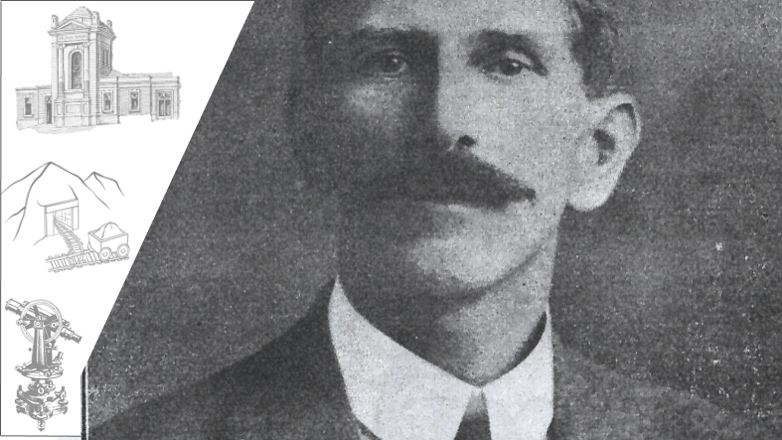
Early Life and Education
Few men connected with South Australian municipal life have had careers as varied and fascinating as Charles Maddison Yeomans, who became Town Clerk and Engineer of the Henley and Grange Corporation between June 1923 and October 1931.
Charles’ parents George and Mary who were married in 1870 left England on the 8th of August that same year on board the Clipper ship “Anglesey” arriving in Melbourne some 140 days later. It must have been a difficult voyage for Mary as Charles was born (at sea) on the 27th of September 1870, only 49 days into the long journey.
Unassisted passenger lists (1852-1923) Series VPRS: 947
[Area highlighted shows George and Mary Yeomans and records the ‘birth of a male during voyage’
(Source: Public Office of Victoria)
The family moved from Melbourne to Burra, S.A. in 1876 where Charles’ father worked as a railway engine driver then again to Pt. Pirie, S.A. in 1879 as a foreman in the railways. Between 1879 – 1882 Charles went to school in Pt. Pirie and whilst there was awarded a prize of £0 12s 6d (or $1.25) for being ‘dux of the school’. The family then moved to Adelaide in 1882 when his father became a Superintendent in the Islington Railway Workshops and Charles continued his education at Sturt Street School which opened in 1883 and later at the Adelaide Collegiate School in the Christ Church schoolrooms, North Adelaide where in the 4th Form (which is broadly equivalent to Year 10 today) he won prizes in both geography and algebra.
 Pupils and staff of Sturt Street School 1907
Pupils and staff of Sturt Street School 1907
(Courtesy of the State Library of South Australia B 3356)
[Editor Notes]
- It is reasonable to assume that Yeomans’ academic achievements described above reflected both his aptitude for mathematics and his disciplined approach to learning, qualities that would serve him well in his later engineering and surveying career.
- Please click on each image in the story to enlarge it for improved detail and readability.
References
ADELAIDE COLLEGIATE SCHOOL. (1886, December 23). The South Australian Advertiser (Adelaide, SA : 1858 – 1889), p. 7. Retrieved October 16, 2025, from http://nla.gov.au/nla.news-article37164649
BACK AFTER 53 YEARS (1939, February 18). Recorder (Port Pirie, SA : 1919 – 1954), p. 4. Retrieved October 16, 2025, from http://nla.gov.au/nla.news-article96296363
MUNICIPAL ENGINEERS (1928, June 18). News (Adelaide, SA : 1923 – 1954), p. 8 (HOME EDITION). Retrieved October 16, 2025, from http://nla.gov.au/nla.news-article129131788
Public Record Office Victoria, Inward Overseas Passenger Lists, VPRS 947/P0000, Sep – Dec 1870, https://prov.vic.gov.au/archive/3B3D2DF1-F96C-11E9-AE98-E9BFA8524AEB?image=150
First Steps in Engineering
After completing his education in 1886, Yeomans entered the workforce with Packard and Sanders, a well-known Adelaide firm of surveyors. He remained with them for two years, gaining valuable experience in fieldwork and mapping. His early career then took him into the Engineer-in-Chief’s Department of the Colony where he was contributed to the surveys of two important South Australian railway lines – the Oodnadatta to Alice Springs extension and the Blyth to Snowtown line. These were quite demanding undertakings, requiring not only technical skill but also resilience in the face of harsh working conditions.
Following this, he was engaged for four years on the construction of the Happy Valley Reservoir outlet tunnel. This ambitious project required tunnelling through a hill to create a stable water outlet. Yeomans, along with the construction manager Mr. J. J. Leahy worked as two tunnelling teams, digging from opposite sides of a hill. Their tunnels met in the middle with an error of less than three-quarters of an inch (about 1.78cm). For a young engineer in his early twenties, this was an extraordinary achievement and an early sign of his exacting standards.
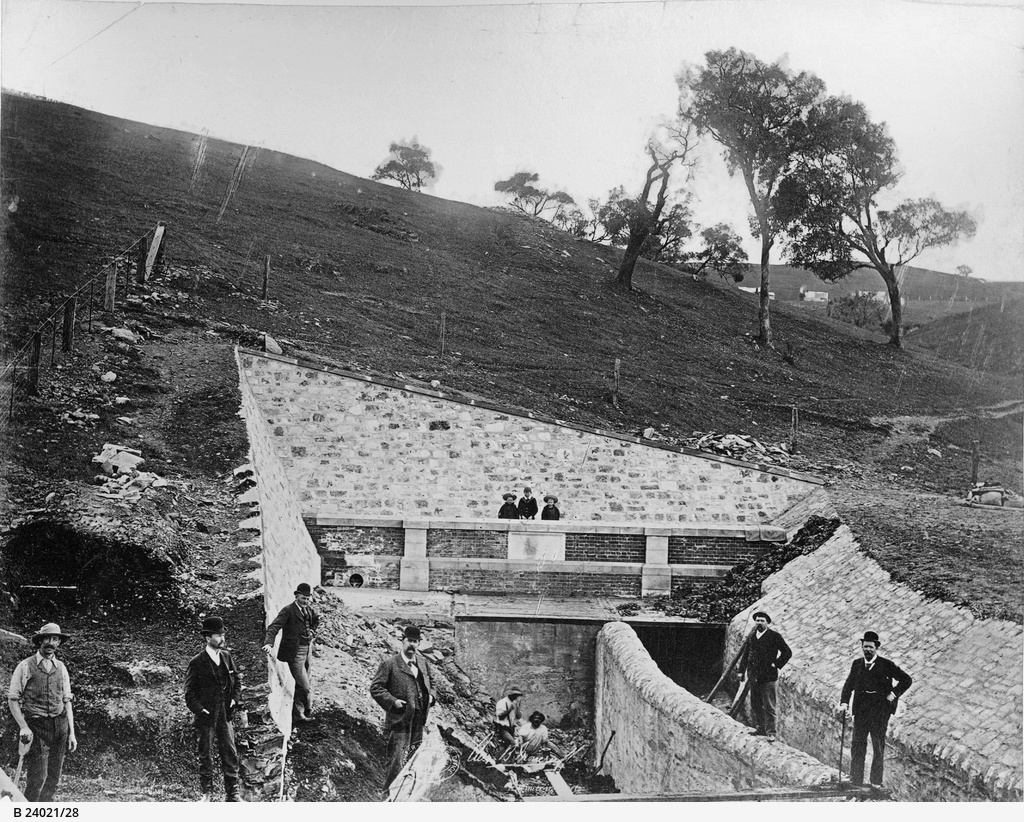 Happy Valley Reservoir Outlet Tunnel c. 1894
Happy Valley Reservoir Outlet Tunnel c. 1894
(Courtesy of the State Library of South Australia B 24021/28)
Where’s Charlie?
Can you spot a young Charlie Yeomans proudly admiring his work in the photograph above? Hint: He would have been about 24 years old when this photo was taken.
Click this link to record a response anonymously and see if you are correct!
References
MUNICIPAL ENGINEERS (1928, June 18). News (Adelaide, SA : 1923 – 1954), p. 8 (HOME EDITION). Retrieved October 16, 2025, from http://nla.gov.au/nla.news-article129131788
Public Works. (1895, July 26). Southern Cross (Adelaide, SA : 1889 – 1954), p. 7. Retrieved October 16, 2025, from http://nla.gov.au/nla.news-article165891900
Goldfields and Adventure
In 1895, Yeomans left Adelaide for the Western Australian goldfields, where he was appointed chief surveyor for the London Exploration Company, a position he held for four years. His responsibilities included mapping and surveying new mining areas in some of the most remote and demanding parts of the colony.
Life on the goldfields was rugged, but Yeomans seemed to thrive in this environment.
A story from this period reveals a lighter side to his personality. On one occasion, while working in the remote ‘Granites’ region, he found a tree with a tin plate bearing the inscription “M.T. ’28.” Apparently, it had been left there by Michael Terry, the explorer. Nearby he found another piece of tin on a tree marked “B.C. 32,” which he believed was left by a cynical prospector. Seeing the humorous side of the situation, Yeomans marked on a paper from his cigarette tin that he “had no idea the tree was marked 32 years before Christ” and that if the finder of his message called at the Stock Exchange Club in Adelaide, he would find “a dozen bottles of beer awaiting him on ice”. The beer was never claimed.

(Source: Advertiser (Adelaide, SA: 1931 – 1954), Friday 19 April 1935, page 9)
After four years in Western Australia, Yeomans joined the service of the Gold Exploration Company as chief surveyor and was working in Johannesburg, South Africa when the Boer War broke out on the 11th of October 1899.
[Editor Note]
This humorous anecdote probably shows that, alongside his technical skills, Yeomans carried a sense of camaraderie and good humour — traits that would have made him popular among colleagues.
References
BACK AFTER 53 YEARS (1939, February 18). Recorder (Port Pirie, SA : 1919 – 1954), p. 4. Retrieved October 16, 2025, from http://nla.gov.au/nla.news-article96296363
Cut among the People (1935, April 19). The Advertiser (Adelaide, SA : 1931 – 1954), p. 9. Retrieved October 16, 2025, from http://nla.gov.au/nla.news-article37281976
MUNICIPAL ENGINEERS (1928, June 18). News (Adelaide, SA : 1923 – 1954), p. 8 (HOME EDITION). Retrieved October 16, 2025, from http://nla.gov.au/nla.news-article129131788
Service in the Boer War
With a strong sense of patriotic duty, and with the approval of his employers (as mining operations were now suspended) Yeomans made his way to Durban and enlisted in the Imperial Light Infantry on the 21st of October 1899, throwing himself into active service.
He saw action in some of the fiercest fighting of the campaign including the Tugela Heights engagements, a series of hard-fought battles to relieve the besieged town of Ladysmith. His performance there led to his appointment as a Sergeant to the Bodyguard of the Commander-in-Chief, a prestigious posting that placed him at the heart of the British campaign. With the Bodyguard unit, he served across Cape Colony, Orange River Colony, and the Transvaal, often under dangerous and demanding conditions.
For his service, Yeomans was awarded two of the most highly regarded campaign medals of the war: the Queen’s Medal with six clasps and the King’s Medal with two clasps. His service record first lists him as Corporal, Service Number 940 in the Imperial Light Infantry then as Sergeant, Service Number 22269 in the Commander Chief’s Bodyguard Unit.
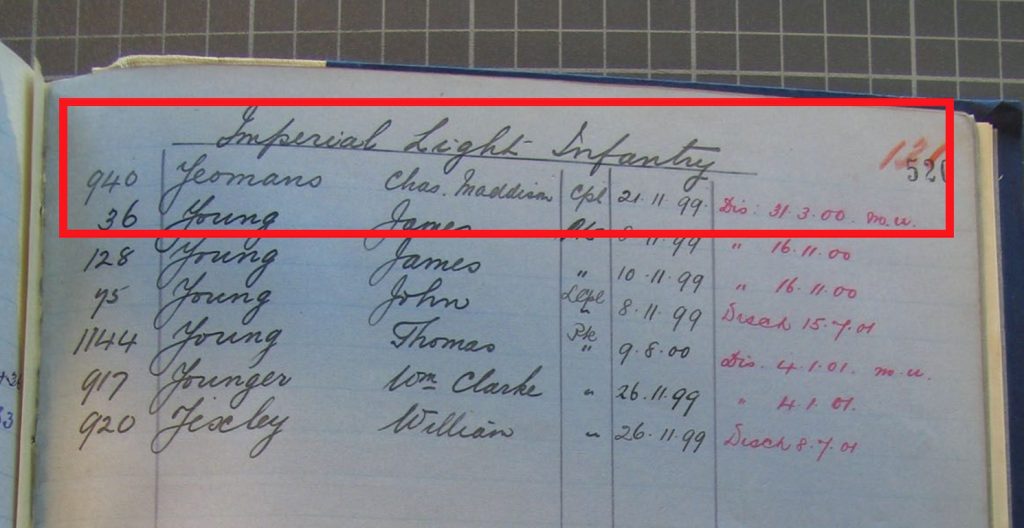 Boer War Listing for C.M. Yeomans – Imperial Light Infantry
Boer War Listing for C.M. Yeomans – Imperial Light Infantry
(Source: Boer War Records)
 Boer War Listing for C.M. Yeomans – Cic Body Guard
Boer War Listing for C.M. Yeomans – Cic Body Guard
(Source: Boer War Records)
 Queen’s medal Queen’s medal(showing 4 clasps) |
 King’s medal King’s medal(showing 2 clasps) |
https://www.bwm.org.au/medals.php |
|
When the war ended, Yeomans chose to remain in South Africa, where he continued to work as a mining engineer/surveyor. This marked the beginning of a period in his life where his engineering skills would take him around the globe.
References
MUNICIPAL ENGINEERS (1928, June 18). News (Adelaide, SA : 1923 – 1954), p. 8 (HOME EDITION). Retrieved October 16, 2025, from http://nla.gov.au/nla.news-article129131788
Roe, C. (1998) Oz-Boer Database project, Retrieved October 16, 2025, from https://members.pcug.org.au/~croe/ozb/oz_boer_more.cgi?record=23521
The Australian Boer War Memorial (n.d.), Medals https://www.bwm.org.au/medals.php
Railways, Mines, World Travels & More Wars
From 1902 to 1904, he was appointed chief surveyor of the East Rand Proprietary Mines in South Africa, one of the largest and most profitable gold-mining companies in the world at the time. The East Rand mines were technically demanding, requiring constant innovation and this position placed him at the cutting edge of mining engineering in the early 20th century. In 1904, he moved to Mexico, taking up the role of chief surveyor and railway engineer for the Elo Mining and Railway Company. Here, his task was formidable: to build a narrow-gauge railway (3 ft. 3 in. or about 1.0 m in width) through the mountains at 13,000 feet (or nearly 4 km) altitude. Such work required not only engineering skill but also physical endurance in extreme conditions.
By 1908, Yeomans was travelling again, this time to Java, where he was engaged to report on a proposed 240-kilometre railway line for a French syndicate. In 1909, he returned to Australia, where he became manager of Payne’s Find Gold Mine in Western Australia. The mine was part of a new goldfield discovered only a few years earlier, and Yeomans’ leadership there added further breadth to his already diverse career in mining and surveying.
However, by 1918, Yeomans found himself back in South Australia at a very different crossroads. At the age of 47, with the First World War in its final year, he enlisted on the 18th of January 1918 and was deemed “fit for home service”. Private Charles Yeomans served with the 4th Military District Reserve Guard at Mitcham Camp, but after 86 days, he requested and received adischarge on the 18th of April 1918.
 |
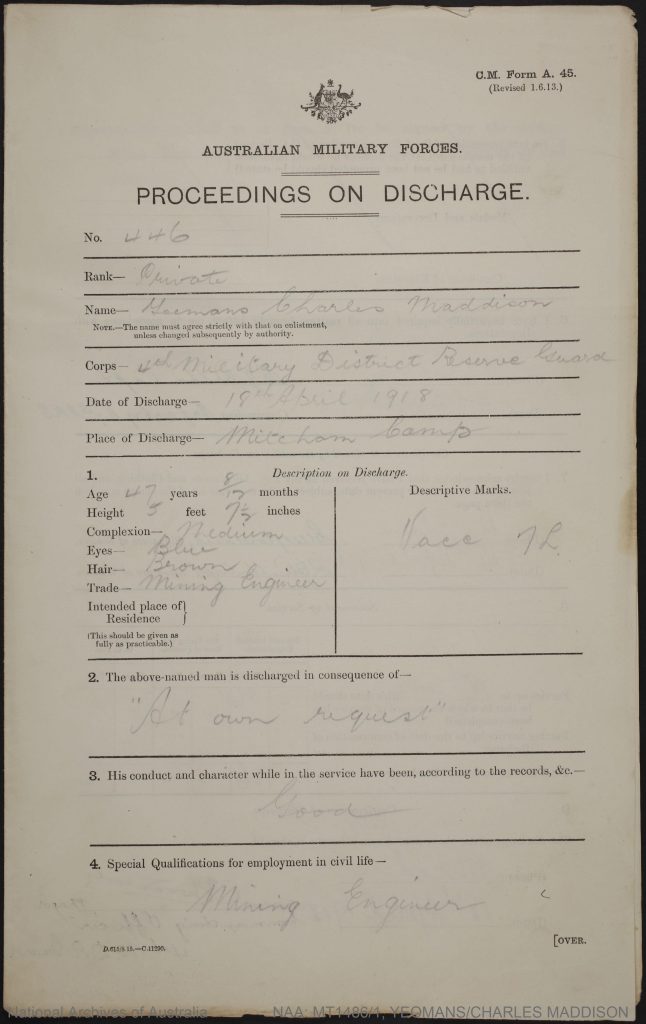 |
Charles Yeomans Enlistment (L) and Discharge Papers (R)
(Source: National Library of Australia – Record MT1486/1)
Following his brief enlistment, Yeomans was employed as an assistant surveyor to the Adelaide Corporation (now the Adelaide City Council). During this period, he supervised the wood-blocking of Adelaide’s roads, a construction technique that laid timber blocks beneath a tarred surface, providing smoother, quieter streets for a growing city.
[Editor Notes]
- The blend of international and local experience in mining and railway engineering demonstrated Yeoman’s capacity to adapt his knowledge to diverse landscapes and climates, laying the groundwork for his most significant civic achievement — his appointment as Town Clerk of the Henley & Grange Council.
- At the late stage of the WWI, older volunteers with essential civilian skills were released from duty so they could return to important work increasingly in demand as the state prepared for post-war recovery.
References
MUNICIPAL ENGINEERS (1928, June 18). News (Adelaide, SA : 1923 – 1954), p. 8 (HOME EDITION). Retrieved October 16, 2025, from http://nla.gov.au/nla.news-article129131788
National Archives of Australia, Charles Maddison Yeomans Wold War I Enlistment Records, Retrieved October 16, 2025, https://recordsearch.naa.gov.au/SearchNRetrieve/Interface/ViewImage.aspx?B=60234993
Town Clerk & Engineer of Henley & Grange
In 1923, Charles Maddison Yeomans accepted the role of Town Clerk and Engineer for the relatively new Corporation of Henley & Grange. For the next eight years, until October 1931, he applied the breadth of his international engineering and surveying experience to the growth and improvement of the seaside townships.
(Source The News, Monday, June 18, 1928, page 8)
During his years in office, Yeomans planned and managed many projects to improve the Henley and Grange foreshore: stabilising the sand slopes, reclaiming frontage where useful, and generally improving the beachfront amenity for bathing and public use.
He quickly became a popular and respected Town Clerk, his standing in the community reflected in the naming of the Henley Beach children’s playground he conceptualised, designed, supervised and contributed to the construction of, as “Yeomans Playground”. At its southern entrance, ornate C.M. Yeomans Gates were erected near the musical merry-go-round that stood at the end of the sideshows.
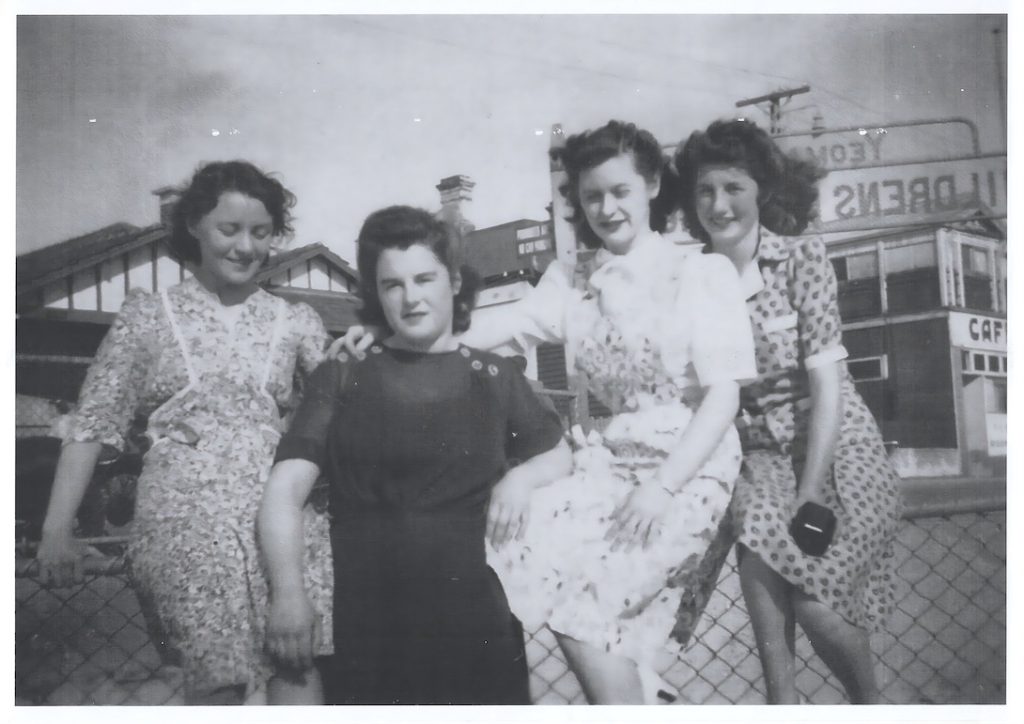 Young women on a fence, with the Yeomans gates just behind c. 1926
Young women on a fence, with the Yeomans gates just behind c. 1926
(Source: H&GHS Collection)
The playground was a major attraction of its time, featuring a scenic railway, giant swings, slippery dip, see-saws, round-about, swinging boats, walking beams, horizontal bars, and even a large dolls’ house. Built at a cost of about £500, (or about $50,000 in 2025 after inflation) it represented a significant investment in recreation and community life. At a time when public play spaces were scarce, this facility provided local children with a safe and purpose-built area for recreation. It also reflected new thinking about child development, health, and community wellbeing in the 1920s.
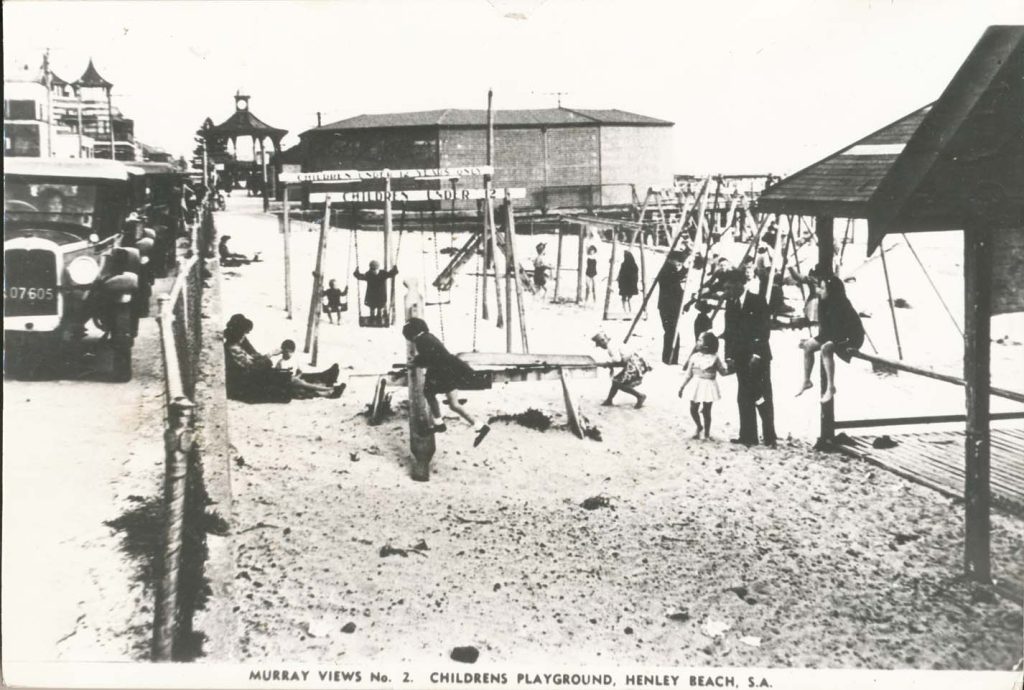 Yeomans Playground, Esplanade, Henley Beach c. 1926 (looking south)
Yeomans Playground, Esplanade, Henley Beach c. 1926 (looking south)
(Source: H&GHS Collection)
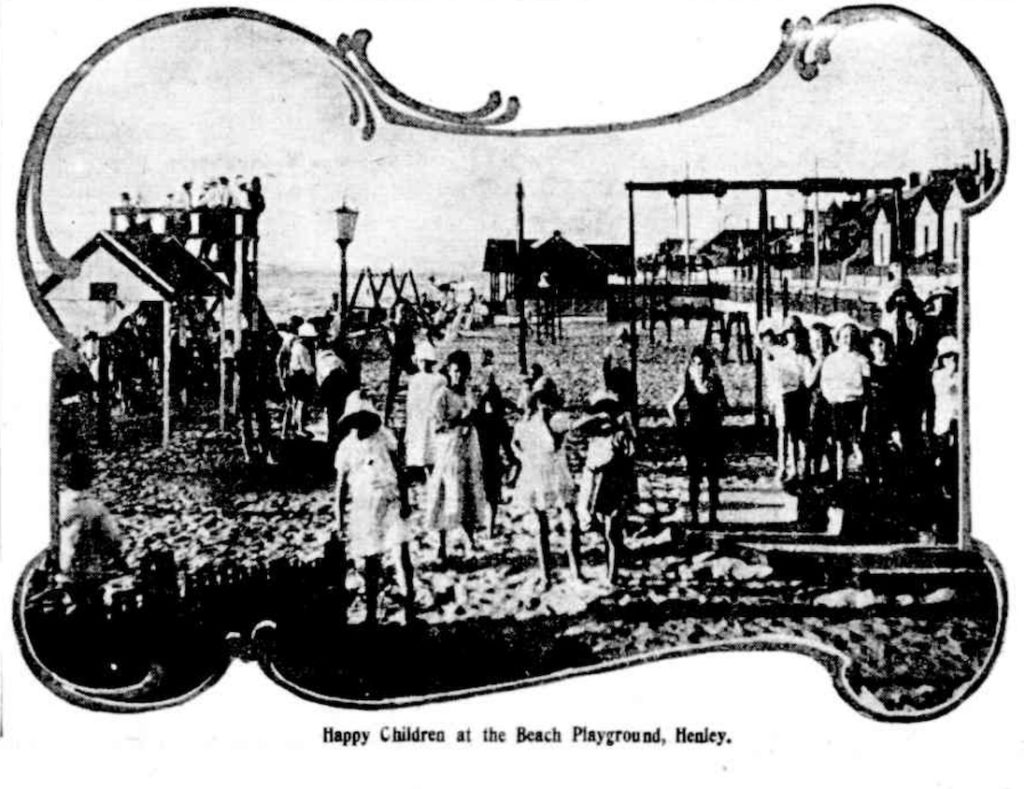 Yoeoman’s Playground 1927 (looking north)
Yoeoman’s Playground 1927 (looking north)
(Source: The Register, Saturday, January 29, 1927, page 8)
Another of his schemes was the construction of bathing houses at Henley Beach, described at the time as “being 15 ft x 25 ft (4.5m x 7.6m) and attractively finished in concrete with leadlight doors”. Each would contain a shower bath and electric light, be fully floored, and have provision for ventilation. These facilities gave residents and visitors alike greater access to the beach, at a time when “surf bathing” was becoming a defining feature of South Australian coastal life. People leasing them were required to pay £110 cash (or about $11,000 in 2025 after inflation) for the construction of a bathing house and were granted a 10-year lease at £0 2s 6d a year (or about $12.50 in 2025 after inflation). Bathing houses became the property of the Council when the lease expired.
|
(Source: The News, Wed, Nov 21, 1928, p. 6) |
 Bathing Houses @ Henley South Bathing Houses @ Henley South(Source: H&GHS Collection) |
 (Source: H&GHS Collection) (Source: H&GHS Collection) |
Yeomans was also responsible for the designing and construction of a concrete road near the Viaduct at Henley Beach in 1925-6. At the time it was said to be “one of the finest bits of concrete work of its kind in Australia.” It was constructed at a cost of £8,000 (or about $785,000 in 2025 after inflation) and offered a durable, smooth, and modern roadway over an area which was often flooded in winter. It was reported in December 1925 that as a tribute to the commendable way in which the men had done the work, Yeomans entertained them on completion at the Henley Town Hall.
Later (possibly in the 1950s) the Highways Department pulled the road up and buried a lot of the concrete in the creek along Cudmore Terrace.
Workmen spreading reinforced concrete over the low lying section of Viaduct Rd, Henley Beach
(Source: News, Thursday 17 December 1925)
In 1926 he organised construction of three miles (nearly 5 km) of new kerbed footpaths (made ready for tar surfacing) and the renovation of Kirkcaldy Road (now Grange Road), to improve pedestrian and vehicle movement.
He also managed a project for the extension of floodlighting along the Henley foreshore after the existing lights were damaged and in disrepair and presented a schedule to Council for nine additional lights to be installed at Kirkcaldy and another ten for Grange.
[Editor Note]
These projects (and the many others he was involved in designing but not mentioned here), demonstrates Yeomans’ commitment not only to engineering excellence but also to community improvement. His initiatives balanced innovation with practicality and helped to ensure that the townships of Henley and Grange possessed infrastructure and amenities that would serve generations of residents and visitors in years to come.
References
BACK AFTER 53 YEARS (1939, February 18). Recorder (Port Pirie, SA : 1919 – 1954), p. 4. Retrieved October 16, 2025, from http://nla.gov.au/nla.news-article96296363
Brightening Henley (1925, June 23). News (Adelaide, SA : 1923 – 1954), p. 4 (HOME EDITION). Retrieved October 16, 2025, from http://nla.gov.au/nla.news-article129737697
HENLEY BEACH AND GRANGE (1927, January 29). The Register (Adelaide, SA : 1901 – 1929), p. 8. Retrieved October 16, 2025, from http://nla.gov.au/nla.news-article54878217
Henley & Grange Historical Society, Journals No. 17 (1996), No. 30 (2009) and No. 32 (2011)
HENLEY BEACH ROADS. (1926, July 28). The Advertiser (Adelaide, SA : 1889 – 1931), p. 13. Retrieved October 16, 2025, from http://nla.gov.au/nla.news-article46534015
Henley Floodlighting (1930, December 17). News (Adelaide, SA : 1923 – 1954), p. 10 (HOME EDITION). Retrieved October 16, 2025, from http://nla.gov.au/nla.news-article128955192
Henley Improvements. (1927, January 29). The Register (Adelaide, SA : 1901 – 1929), p. 8. Retrieved October 16, 2025, from http://nla.gov.au/nla.news-article54878214
Lighting at Henley Beach (1928, November 21). News (Adelaide, SA : 1923 – 1954), p. 6 (HOME EDITION). Retrieved October 16, 2025, from http://nla.gov.au/nla.news-article129020683
MUNICIPAL BATHING HOUSES. (1928, May 26). The Register (Adelaide, SA : 1901 – 1929), p. 3. Retrieved October 16, 2025, from http://nla.gov.au/nla.news-article56636311
MUNICIPAL ENGINEERS (1928, June 18). News (Adelaide, SA : 1923 – 1954), p. 8 (HOME EDITION). Retrieved October 16, 2025, from http://nla.gov.au/nla.news-article129131788
NEW BATHING HOUSES (1927, May 26). News (Adelaide, SA : 1923 – 1954), p. 12 (HOME EDITION). Retrieved October 16, 2025, from http://nla.gov.au/nla.news-article129149843
Reserve Bank of Australia (n.d.), Pre-Decimal Inflation Calculator, https://www.rba.gov.au/calculator/annualPreDecimal.html
WORKMEN SPREADING REINFORCED CONCRETE OVER LOW-LYING SECTION OF VIADUCT ROAD, HENLEY BEACH (1925, December 17). News (Adelaide, SA : 1923 – 1954), p. 18 (HOME EDITION). Retrieved October 16, 2025, from http://nla.gov.au/nla.news-article129748856
Personal Life
Yeomans was a confirmed bachelor. He was a member of the Henley Beach Gollywogs Bachelor’s Club, and boarded locally, possibly at the Ventnor Guest House on the North Esplanade at Henley Beach and perhaps at local hotels during his time on Council.
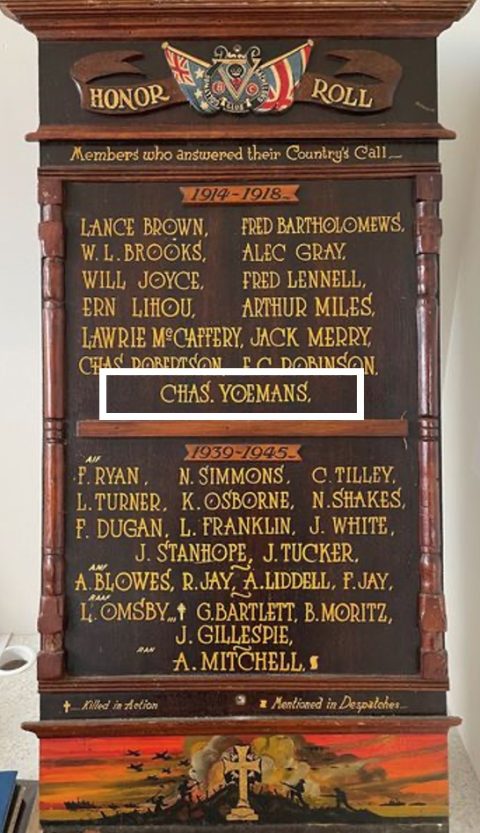
Gollywog Bachelor’s Club Honour Roll
(Courtesy of Anne Wheaton)
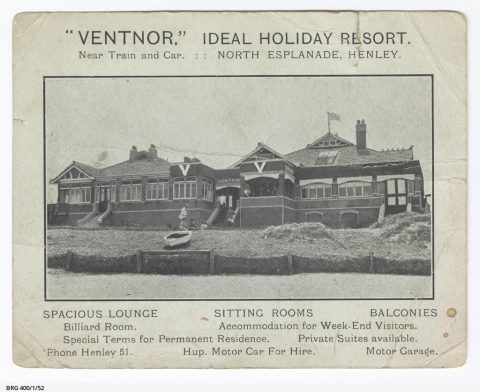 Ventnor Guest House
Ventnor Guest House
(Courtesy of the State Library of South Australia BRG 400-1-52)
Despite his unmarried life, Yeomans had a deep interest in child welfare. Each year, he invited the schoolchildren of Henley and Grange to a free picture show at the Henley Town Hall, which he personally funded. On the day, he would arrive early, standing in the walkway between the dress circles with a bag of lollies, handing one to every child who passed. He also gave talks at schools about his overseas travels and spoke at Anzac Day and Remembrance Day assemblies, often bringing apples with him to distribute amongst the students afterwards.
References
BACK AFTER 53 YEARS (1939, February 18). Recorder (Port Pirie, SA : 1919 – 1954), p. 4. Retrieved October 16, 2025, from http://nla.gov.au/nla.news-article96296363
Henley & Grange Historical Society, Journal No. 32 (2011)
Later Life and Legacy
After leaving Council in 1931, Yeomans gradually withdrew from public life but still remained active in community and veterans’ organisations. He continued as a long serving member of the Stock Exchange of Adelaide Club and of the Returned Sailors and Soldiers’ Imperial League (R.S.S.I.L.), now called the RSL. He served as the inaugural Vice President of the Henley & Grange Sub-Branch in 1924.
On Coronation Day, 12 May 1937, he presented a sundial to Henley Beach School on behalf of the sub-branch, recognising the children’s efforts on Anzac Day.
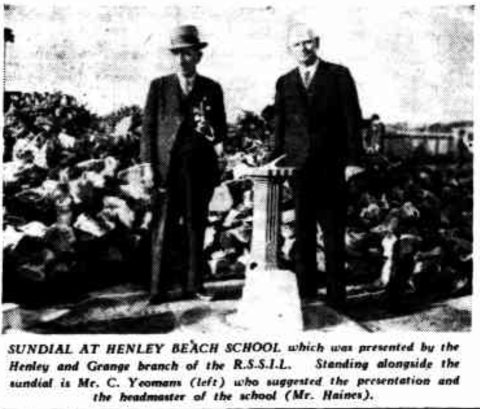 (Source: The Mail, Sat, May 22, 1937, p. 8) |
Opening of the C.M. Yeoman’s Gates 22/8/46 |
He served as Vice President of the Blinded Soldiers’ Association, and in a personal gesture of support, he wove scarves by hand for blind veterans. His other hobbies included music and the collecting of photographs and locomotive plates. He also procured broken jewellery from city emporiums and repaired them. At Christmas he gave the mended bangles, brooches, and other ornaments to the Adelaide Children’s Hospital to distribute to patients and to outback children who visited the city.
However, by 1944, his health was in decline, and he spent time as a patient at the Lady Galway Home for Convalescent Soldiers at Henley Beach before it closed in 1946. During time there, he was deeply moved when the Henley Beach School named the entrance to a new playground the “C.M. Yeomans Gates”, in recognition of his generosity and longstanding interest in children’s welfare. The photograph (above – right) taken at the official opening of the gates on the 22nd of August 1946 shows Yeomans (seated) among the attendees. At that time, he would have been 76 years old.
Sadly, his health continued to decline and Yeomans died at his family home in Prospect, on the 27th of June 1948. He was buried at the North Road Cemetery, and on the day of his funeral the Henley and Grange Town Hall flag flew at half-mast in his honour.
|
|
Funeral Notice |
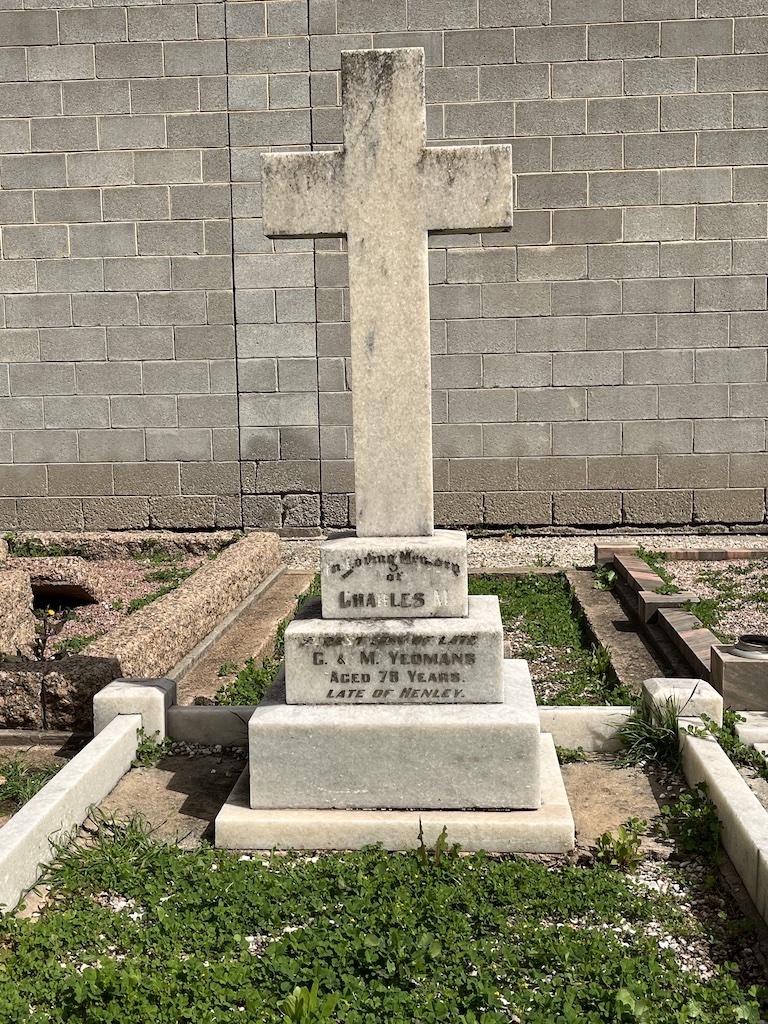 Grave and headstone of Charles Yeomans @ North Road Cemetery
Grave and headstone of Charles Yeomans @ North Road Cemetery
(Photo by Roger Edmonds, 2025)
In recognition of his service, Yeomans Avenue in Henley South was named in his honour. Later, in the 1960s, a group of 96 South Australian Housing Authority flats across 14 three-storey blocks were built nearby and also named “Yeomans.” These buildings were given a fresh external renovation in 2019–20.
Yeomans Flats @ Henley South
(Photo by Roger Edmonds, 2025)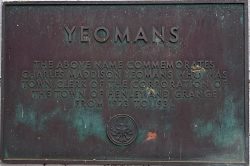 Small bronze plaque on LHS wall of Yeomans Flats
Small bronze plaque on LHS wall of Yeomans Flats
(Photo by Roger Edmonds, 2025)
References
BACK AFTER 53 YEARS (1939, February 18). Recorder (Port Pirie, SA : 1919 – 1954), p. 4. Retrieved October 16, 2025, from http://nla.gov.au/nla.news-article96296363
Family Notices (1948, June 28). The Advertiser (Adelaide, SA : 1931 – 1954), p. 8. Retrieved October 16, 2025, from https://trove.nla.gov.au/newspaper/article/43772500
Family Notices (1948, July 1). Chronicle (Adelaide, SA : 1895 – 1954), p. 39. Retrieved October 16, 2025, from https://trove.nla.gov.au/newspaper/page/8705583
HENLEY AND GRANGE “DIGGERS.” (1924, May 12). The Register (Adelaide, SA : 1901 – 1929), p. 13. Retrieved October 16, 2025, from http://nla.gov.au/nla.news-article57396128
Henley & Grange Historical Society, Journals No. 17 (1996), No. 30 (2009) and No. 32 (2011)
Out Among The People (1944, August 24). Chronicle (Adelaide, SA : 1895 – 1954), p. 35. Retrieved October 16, 2025, from http://nla.gov.au/nla.news-article92803437
Returned Soldiers’ Gift To School (1937, April 24). The Advertiser (Adelaide, SA : 1931 – 1954), p. 27. Retrieved October 16, 2025, from http://nla.gov.au/nla.news-article74353989
Community Industry Housing Assocation (2019). Multi-million dollar housing maintenance program to improve homes and boost economy, Retrieved October 27 2025, https://chiasa.org.au/multi-million-dollar-housing-maintenance-program-to-improve-homes-and-boost-economy
Researcher & Editor's Notes
Charles Maddison Yeomans distinguished career reflects a man who met challenges across continents — from the mines of Africa and the mountains of Mexico to the evolving suburbs of South Australia. Combining technical expertise with civic purpose, he helped shape Henley and Grange during a period that valued planned community spaces, improved infrastructure, and seaside recreation. His legacy stands as a reminder that modern suburban life was built by those whose abilities, talents and vision extended widely but whose deepest commitment remained to their local community.
People who visit our History Room @ Ngutungka Henley (which was Yeoman’s office while he was Town Clerk and Engineer) often admire the magnificent 180cm wooden-framed photographic panorama of the Henley Beach foreshore on display. Yet few know its origin and the name of generous benefactor who commissioned and presented it to the local community. Click the photo below to discover more!
(Source: H&GHS Collection)
The research for this story has been compiled from both primary and secondary sources, including those in the State Library of South Australia, Trove, the research portal of the the National Library of Australia, the National Archives of Australia, other websites and from Henley & Grange Historical Society Journal articles, the content of which can sometimes be based on personal recollections. While every effort has been made to substantiate the historical accuracy of the sources used in this story, the Henley & Grange Historical Society cannot guarantee that it represents a complete or fully accurate account of Charles Yeomans’ life. The story is presented in good faith and is not intended to offend any person, living or deceased.
As with many historical reconstructions, minor inconsistencies can arise between different sources. For instance, accounts vary on Yeomans’ age at his death. His World War I enlistment papers list his birth as 28 September 1870, and his death was recorded on 17 June 1948 — which would make him 77 years old at the time. However, his funeral notice cites 76 years, while his headstone claims 78!
Generative Artificial Intelligence has been used to assist in refining the narrative by improving flow and grouping related details without altering the factual integrity of the research.
Researched and edited by:
Roger Edmonds
B. App Sc, (App Geology), Grad Dip T. (Sec), Grad Dip Ed. (Ed Computing)
October, 2025
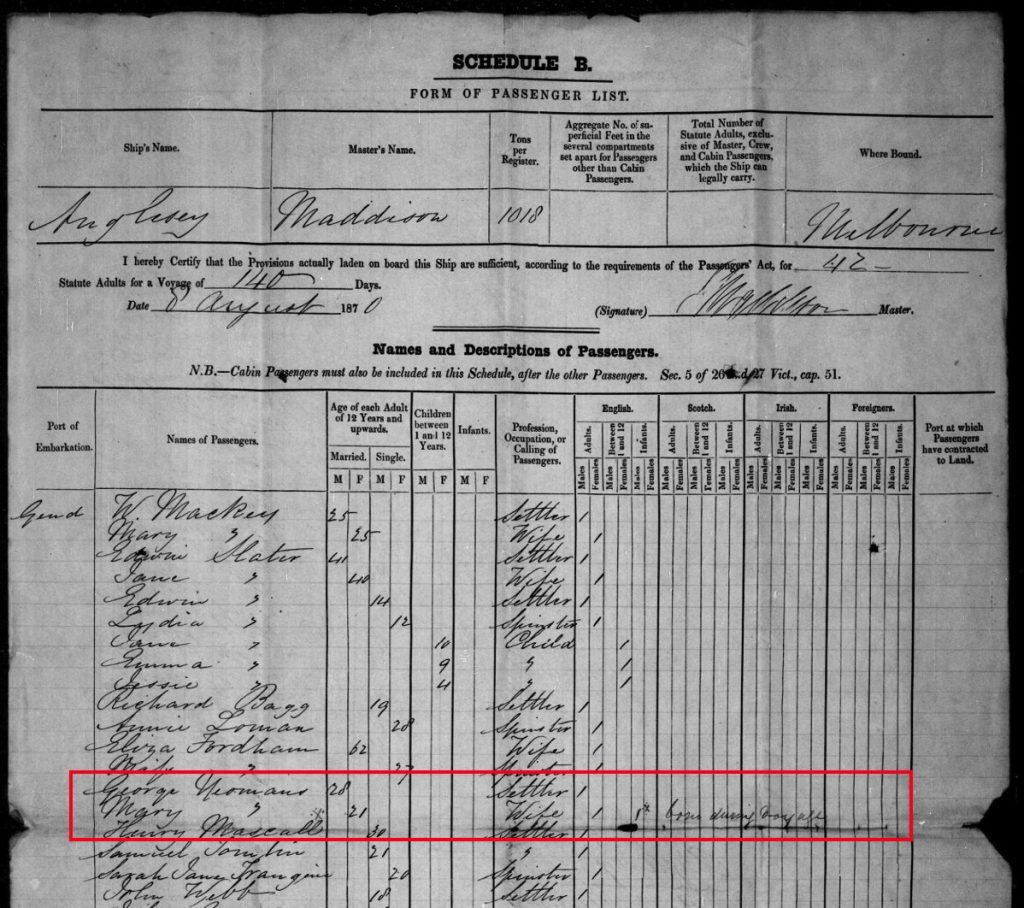
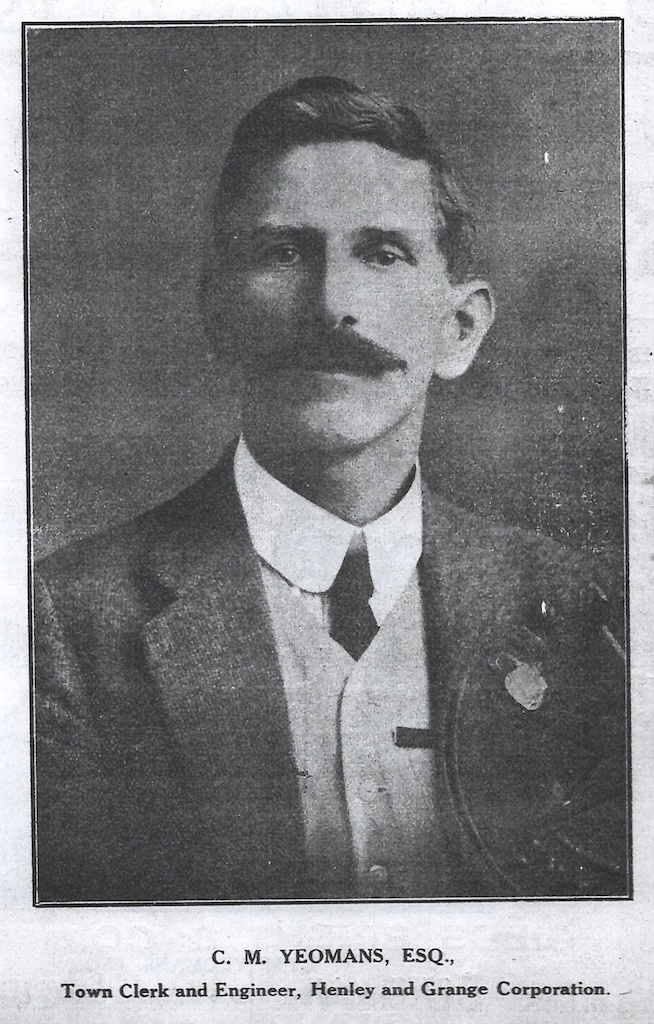

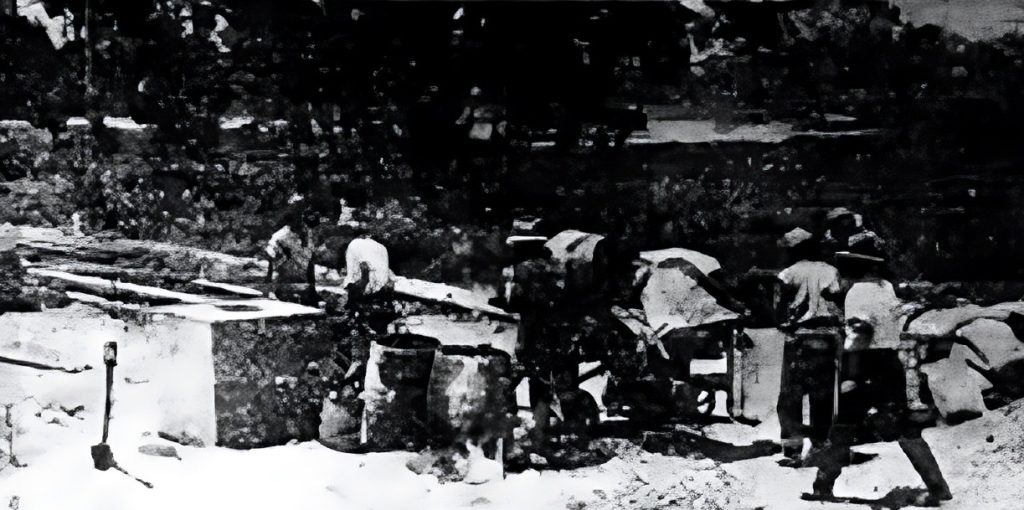
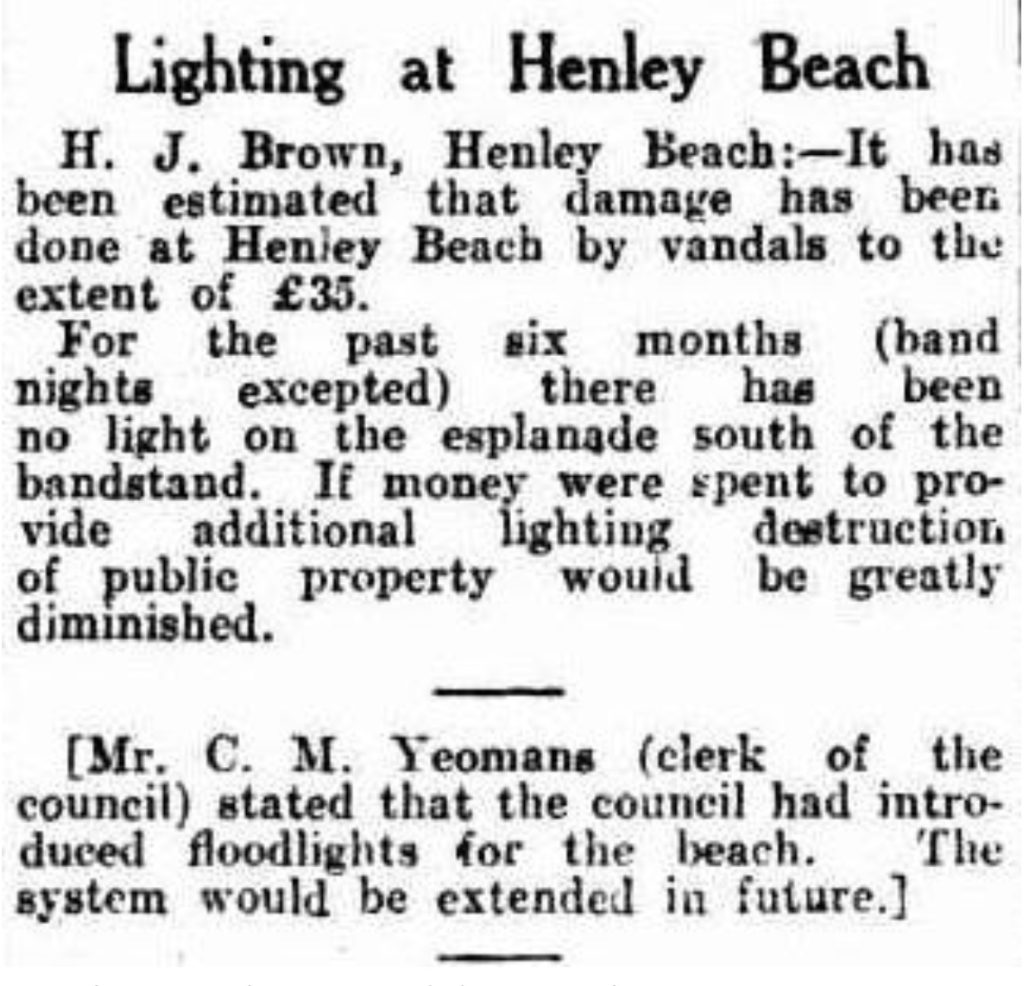
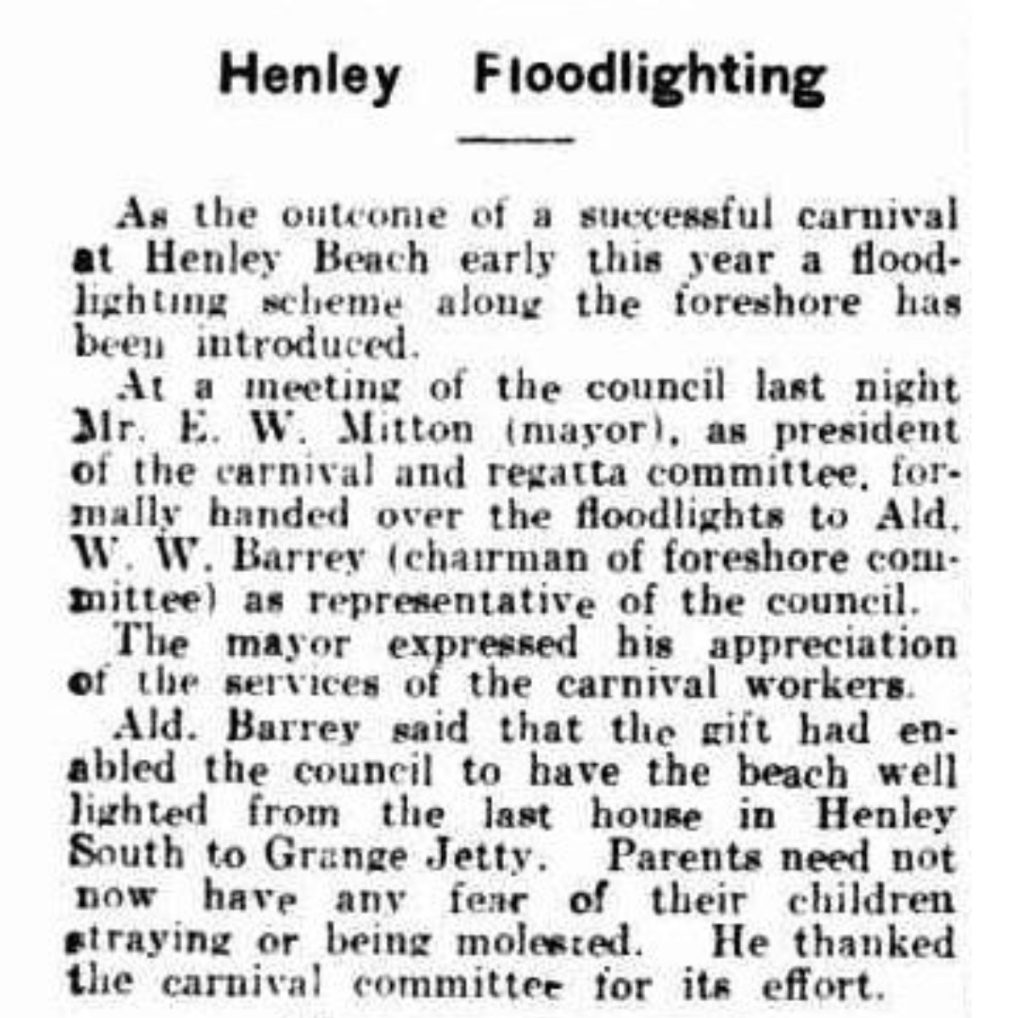
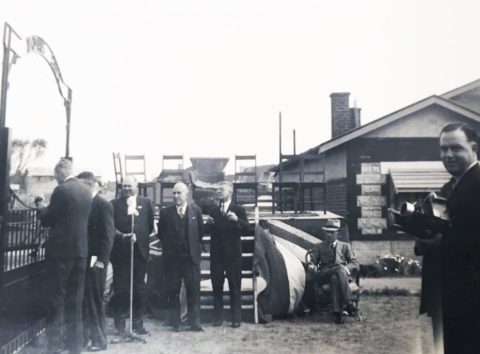
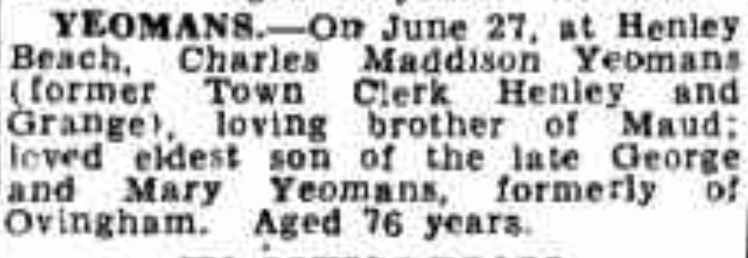

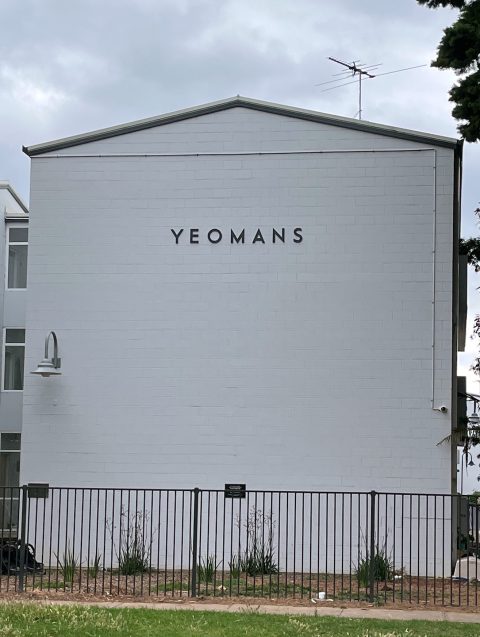

And to think that the current H&GHS history room was Yeoman’s office between 1923 – 1931.